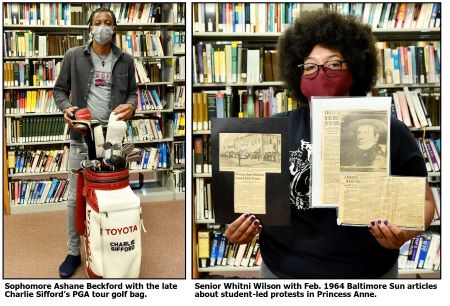A trio of undergraduates get an up-close look at UMES’ history

Three undergraduates — two who are May 2021 graduation candidates — took a crash course this spring in the University of Maryland Eastern Shore’s colorful history and were paid for the privilege of doing so.
The Institute of Museum and Library Services, an independent federal agency that supports the nation’s libraries, awarded UMES a $50,000 grant a year ago that is now being used to reorganize and modernize its archives.
Because the undertaking is labor-intensive, funding was set aside to compensate student-interns to comb through Frederick Douglass Library’s special collection room, laying the groundwork for making old records and memorabilia more accessible to scholars, students and the curious.
Sophomore Ashane J. Beckford and seniors Ayanna E. Lynn and Whitni O. Wilson emerged as the top choices from a deep pool of applicants. Wilson is studying criminal justice; Lynn is a human ecology major specializing in dietetics; Beckford is a student in the Department of the Built Environment, formerly construction management and technology.
All three brim with enthusiasm when discussing their experiences.
“It was kind of overwhelming at first,” Beckford said. “But I got the hang of it and now there’s a sense of accomplishment. It’s made me more patient.”
Beckford said he’s enjoyed examining memorabilia donated by the family of Charlie Sifford, the first Black golfer to compete on the PGA tour.
Wilson said she has come to appreciate the challenge of organizing important papers in special archive boxes, sorting through old black and white photos and cataloging one-of-a-kind items like signs and old trophies.

“I’ve learned so much about this university I didn’t even know,” Wilson said. “I knew about the people who excelled, but it’s the little guy that excites me.”
Newspaper clippings from the 1960s that chronicled then-Maryland State students engaged in civil rights protests in Princess Anne caught Wilson’s eye.
“It’s good to know our alumni were involved,” she said.
When Wilson came upon an original black-and-white image of Martin Luther King Jr., the May 1959 commencement speaker, she had a one-word reaction: “Wow!” Same when she saw pictures of jazz singer Ella Fitzgerald on campus.
Lynn was startled by protest articles that reported authorities used fire hoses and dogs for crowd control.
Lynn also was fascinated by images of the campus’ physical appearance — photos of buildings no longer in existence, or still standing but transformed.
A newspaper clipping Lynn came across using the word Negro resonated with her because of its obsolescence — and put into perspective the importance of preserving those snapshots of a difficult era for alumni.
Beckford, who is from Jamaica where “football” is what Americans call soccer, said “it took me a few days” to comprehend the role college football played on campus from post-World War II until the 1970s.
He’s hopeful the university will invite him to return to his archive-intern post this fall.
Dr. Arlisha Norwood, a history professor who joined the UMES faculty this academic year, signed on to be part of the archive organization project because “I wanted to get an idea of what was in this (special collections) room.”
Norwood previously taught at Howard University, which she said provided insight into the importance of preserving unique aspects of the history of a historically black institution.
“I’ve learned that everything is important,” Norwood said.
The grant application acknowledged that “the exact nature of (UMES’) archival material is not fully known, but a preliminary survey has identified major record groups such as church records, photographs, theses, sports memorabilia, 16-mm film and over-sized portraits.”
Dr. Marshall F. Stevenson Jr., dean of the university’s School of Education, Social Sciences and The Arts, said after the award was announced he sees the grant allowing “UMES to begin the process of formally institutionalizing its history, allowing students and the larger community to see its role in the growth of educational opportunities for African Americans in the state of Maryland, and in particular, the Eastern Shore.”

